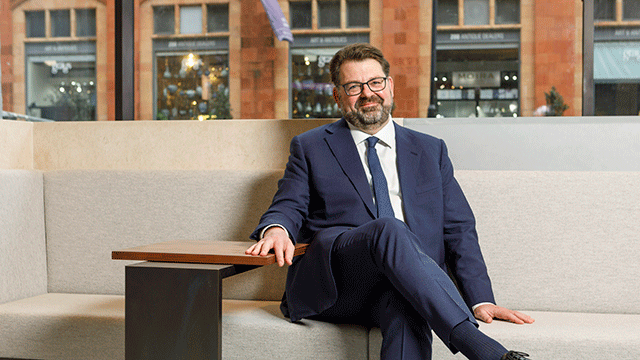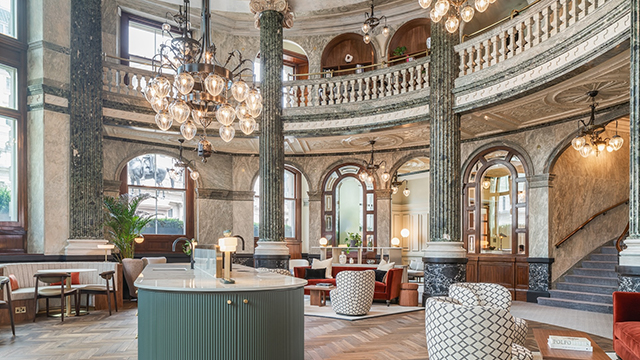France and the UK still dominate but states such as Poland and Moscow are on the way up
In terms of fruit and vegetable analogies for the European industrial and logistics market, it’s time to re-write the book. The banana – the swathe of the market stretching from London to Barcelona (see diagram opposite ) – has been stretched beyond recognition. The carrot – the market area stretching from London to Milan via Hamburg – is getting longer, and there is now a chilli on the scene, representing a new market corridor from Benelux to Eastern Europe, via Italy.
“There is a lot more space now that people are pushing east,” says Tim Johnson, head of international industrial agency at King Sturge. He adds that the market’s area across Europe is “shaped like a very ugly banana now – it’s a lot rounder”.
There has been no change in the traditional markets in Europe. The UK and France still dominate, accounting for 86% of the investment turnover in Western Europe in 2005. That share shrunk slightly last year, but the old guard are the same – Germany, Belgium, and the Netherlands round off the core, while Spain, Italy and the Nordics comprise the second tier. Yields have continued to fall and hover at around 6% for prime Western European assets, with no sign of falling further.
However, Central and Eastern Europe (CEE) countries are snapping at old Europe’s heels. Here the warehouse market has grown significantly in the past four years. Yields have compressed much faster than those in Western Europe and there is no longer a big gap between the regions.
“It’s getting close to the point where we have a single, level playing field for prime logistics, and CEE is coming into line very quickly,” says Nick Jones, head of Cushman & Wakefield’s cross-border industrial and logistics team.
“We like to call it the chilli, because it’s hot,” says Simon Lloyd, DTZ head of European industrial and logistics, referring to the market corridor incorporating eastern Europe. “You spread risk and get easier access to markets, reducing transportation costs. The balance is changing from west to east, but the west will remain dominant.”
Poland a key market
Poland is the key CEE market. According to DTZ, at the end of last year, CEE had a total stock of 8.75m m². Poland held 2.69m m², 210,000 m² more than Russia. Its industrial output year-on-year was 12.5%, 2.1% more than its nearest competitor, again Russia. In Poland 830,000 m² was leased last year – one-third of the total for the entire region.
“Poland sits in the middle of Europe, and if you go from Berlin to Moscow, or from Gdansk to the Black Sea, you pass Warsaw,” says Johnson. “So it’s no coincidence that Poland is a hotspot.”
Czech Republic and Hungary are close behind. While Poland’s industrial and logistics market covers at least four cities – UK investor/developer Segro, for example, has offices in Warsaw, Poznan and Katowice and may open one in Gdansk – the other CEE countries’ markets are largely restricted to their capital cities.
Companies heading east in search of lower production and labour costs – including third-party logistics firms such as DHL and Maersk, and retailers such as Zara and H&M – have bolstered the market.
“The people who have come here have done very well to date,” says Ben Bannatyne, Jones Lang LaSalle’s regional director for Central Europe in Warsaw. “There are still opportunities. We believe rental growth will happen. Infrastructure is also a worry, mainly the roads. Many new ones are now planned, but you’re never quite sure about them until construction starts.”
Czech Republic and Hungary have the CEE’s best infrastructure, with Poland a little way behind. Bulgaria and Romania, with their recent accessions to the EU, have some way to go before they can see the same kind of development as other CEE countries.
“CEE countries have their own rules,” says Guy Frampton, head of industrial and logistics for Europe, Middle East and Africa at CB Richard Ellis. “Czech Republic is an example of how a country can get its act together and open up to foreign investment.”
Not everyone agrees that CEE countries have good prospects. “It’s a thin, opaque market and if you can buy cheaper in Berlin than Warsaw, it doesn’t make sense to buy in Warsaw,” says Richard Croft, chief executive of industrial specialist Halverton. “It makes me laugh how people talk about CEE as the future of the market. The population is a fraction of northern Europe and the countries lack the infrastructure.”
Spain and Italy are geographically on the fringes of the pan-European market, but play important roles. Many investors say Spain is now overpriced, especially in terms of land value, and its position on the Iberian peninsular makes it rather remote.
“The market is still very healthy but it is moving further from the main cities,” says Ed Farrelly, head of CBRE capital markets research in Madrid. “There is a trade-off between higher rents in cities and lower transport costs, or the other way round outside cities. Small units tend to be closer to cities and larger units away from cities.”
He adds that Barcelona is often cited as a good location for logistics and industrial occupiers, “but that’s a red herring. We have to look at CEE for pan-European hubs. Spain is fairly high in price so that’s one point against it, but its market can grow.”
Prime industrial rents in Spain are among the highest in Europe, at €100 per m² a year in Barcelona – equal fifth most expensive, with Stockholm, out of 42 European cities – and €87 per m² a year in Madrid (13th most expensive in Europe).
Yields in both cities remain at 6%, the same as last year. Valencia, Spain’s third city, has been tipped to grow as a port, but with Barcelona just up the coast this seems unlikely to happen.
“There is a question mark over Spain as we believe real estate is highly priced there,” says Danny Peeters, chief executive of EU logistics at Australian group Goodman, echoing many market players’ sentiments. “Spain’s investment market is still very hot, but we are more reluctant and careful about taking big steps there.”
Italy is similarly detached from the main body of the Continent, although the north remains industrially strong. Like Spain, Italy elicits mixed reactions from developers, investors and agents. Although Segro has opened an office in Milan, rival US company Prologis remains sceptical.
Italy “a difficult market”
“Italy has been one of the more difficult markets,” says Gary Anderson, European president of Prologis. “It’s been stagnant and the transition from a Berlusconi to Prodi government, and the resulting tax changes, were not good for the market. We have a stable business in Italy with 700,000 m² of property, but performance in the past 20 months has been weak.”
Prime Italian yields remain higher and rents lower than in Spain, at 6.75% and €65 per m² a year respectively in Milan. Yield compression is expected but rents are likely to remain the same.
Despite CEE’s rise, Western Europe remains the powerhouse of the region’s industrial and logistics market. Northern France is a hub for the European market with the Île-de-France at its core. This area is expected to see more yield compression.
Germany’s economy has been stagnant for the past 20 years, with the economic burden of unification with the former East Germany still felt and owner-occupation widespread. But the former sick man of Europe is well into its economic recovery.
“Today Germany is the engine of what’s happening in Continental Europe,” says Peeters. “Growth is resulting in demand for new developments and the country acts as a central pivotal point for CEE, making Germany absolutely number one. In terms of investment volumes, we think Germany will still be number one for a couple of years to come.”
The Benelux countries also remain a core market area, home to key ports Antwerp and Rotterdam. The Netherlands’ market recovered last year after weak economic growth in 2005, boosting the industrial market. However, the area suffers from a lack of industrial and logistics space.
“The problem in Belgium and Holland will be the lack of space,” says François de Montpellier, partner at DLA Piper in Brussels. “It’s difficult to find good positions that you can develop. The authorities tried to restrict development. In the south of Belgium it’ll be easier as there is more space, but in the north the price will remain high.”
Despite huge potential, Russia remains the pariah of the market. A joke is circulating that you need a big dog, leather coat and shotgun to get business done there. “Supply is coming through, but it’s very immature and still suffers from a hangover from the communist era,” says CBRE’s Frampton.
Many firms are reluctant to enter the Moscow market because of its lack of transparency, particularly US companies, which have had to adopt more stringent reporting practices following the passing of the Sarbanes-Oxley Act in 2002 in the wake of the Enron scandal.
“We are monitoring Russia because we want to be on top of what’s happening, but we have no plans there in the short term,” says Walter Hens, continental Europe managing director at Segro. “If we moved into Russia, it would be a major step, but we are not sure it has the same maturity as the countries where we are working now. We would maybe have issues with the political situation, too.”
But with 50% stock growth year-on-year and Moscow being the largest capital in Europe, the major players cannot afford to ignore Russia for much longer.










